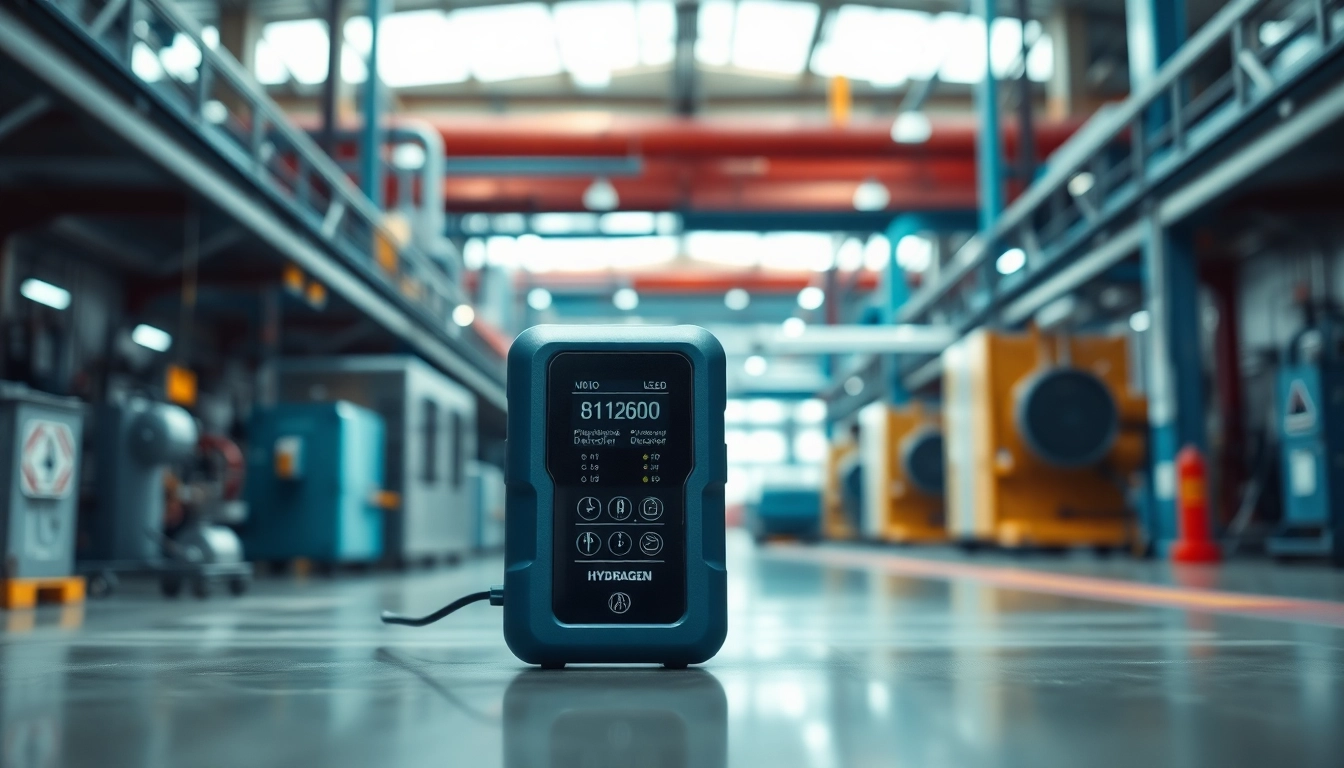Understanding Hydrogen Detectors
In the realm of industrial safety and environmental monitoring, hydrogen detectors play a critical role in identifying the presence of this highly flammable gas. Hydrogen detectors serve vital functions in various settings, including manufacturing facilities, laboratory environments, and even in everyday household situations. Understanding the mechanics and applications of these detectors can empower organizations to enhance safety protocols and ensure compliance with industry regulations.
What is a Hydrogen Detector?
A hydrogen detector is a specialized sensor designed to detect the presence of hydrogen gas (H₂) in the environment. These devices are essential for monitoring hydrogen levels in areas where hydrogen gas is generated, utilized, or stored. Breaches in safety can lead to explosive atmospheres, making it imperative to have reliable detection systems in place.
Hydrogen detectors are categorized based on their operational principles, which include chemical sensors, thermal conductivity sensors, and electrochemical sensors. Each type has unique advantages and suitable applications, from portable units for field inspections to fixed detectors for continuous monitoring in industrial settings.
How Do Hydrogen Detectors Work?
The operational mechanisms of hydrogen detectors can significantly vary depending on the type of sensor used. Typically, a hydrogen detector works by leveraging the interaction between the gas and the sensor materials, which alters certain physical properties like electrical conductivity or thermal conductivity.
One common type of hydrogen sensor is the semiconductor sensor. These devices often utilize metal oxide semiconductors, such as tin dioxide (SnO₂). When exposed to hydrogen gas, the gas interacts with the semiconductor material, resulting in a change in its electrical conductivity. This change is precisely measured and correlated to determine the concentration of hydrogen present in the environment.
Another popular technology involves electrochemical sensors, where hydrogen reacts at the electrode surface, generating a current that correlates with the hydrogen concentration. This method is known for its accuracy and reliability, particularly in low concentrations.
Types of Hydrogen Detectors Available
Hydrogen detectors can be broadly classified into two categories: portable and fixed units.
Portable Hydrogen Detectors
Portable hydrogen detectors are compact and designed for on-the-go use, primarily by safety personnel and first responders. These devices are ideal for areas where hydrogen may be present intermittently, such as during maintenance activities. They typically feature alarms and indicators that alert users to hazardous levels of hydrogen.
Fixed Hydrogen Detectors
Fixed detectors are installed permanently within industrial settings, often in locations where hydrogen is produced or stored. These units offer continuous monitoring and can trigger safety systems, such as ventilation or alarm systems, when hazardous levels are detected.
Importance of Hydrogen Detection in Various Industries
The importance of hydrogen detection cannot be overstated, particularly considering the growing reliance on hydrogen as a clean energy source and industrial feedstock. Here’s a closer look at why hydrogen detection is critical in several key industries:
Hydrogen Applications in Industries
Hydrogen is widely used in various sectors, including:
- Energy Sector: Hydrogen is a critical component in fuel cells and is increasingly employed as a clean alternative to fossil fuels.
- Chemical Manufacturing: Hydrogen is essential in producing ammonia for fertilizers, as well as in many other synthetic processes.
- Metal Processing: Various metal treatments utilize hydrogen for reducing metal oxides or as an inert atmosphere during high-temperature processes.
Occupational Safety and Compliance
Ensuring the safety of personnel working in environments where hydrogen is present is paramount. Regulatory bodies, such as OSHA and EPA in the United States, mandate strict adherence to safety measures, including the installation of hydrogen detectors. Compliance not only ensures the safety of workers but also protects the organization from potential legal repercussions.
Environmental Impact and Regulations
With the growing trend towards sustainability and reduced carbon footprints, monitoring hydrogen emissions is vital. Proper hydrogen detection helps organizations comply with environmental regulations, ensuring that hydrogen does not escape into the atmosphere, thereby preventing potential environmental hazards.
Key Features to Consider in Hydrogen Detectors
When selecting a hydrogen detector, several key features should be evaluated to ensure optimal performance and safety:
Sensitivity Range and Calibration
Sensitivity range indicates the detector’s capability to detect varying concentrations of hydrogen. Different applications may require different sensitivity thresholds. Calibration is equally crucial; regular calibration of detectors ensures accuracy, reliability, and compliance with safety standards.
Portability vs. Permanence
The choice between portable and fixed hydrogen detectors largely depends on the specific environment and applications. Portable detectors are advantageous for flexibility and on-site measurements, while fixed detectors offer the advantage of continuous monitoring and automated responses to hazardous levels of gas.
Alarming Systems and User Interfaces
The alarm systems in hydrogen detectors should be easily distinguishable to ensure prompt attention. User interfaces should also be intuitive and easy to use, allowing personnel to navigate settings and alarms without confusion, especially in high-pressure situations.
Installation and Maintenance of Hydrogen Detectors
Proper installation and regular maintenance are essential to ensure the continued effectiveness of hydrogen detectors. Let’s explore some best practices for each:
Proper Placement for Effective Monitoring
Strategically placing hydrogen detectors is critical. Key consideration factors include:
- Location of potential hydrogen leaks (e.g., near gas lines or storage areas).
- Height of installation, as hydrogen is lighter than air and may accumulate in higher areas.
- Accessibility for maintenance without compromising the monitoring effectiveness.
Routine Maintenance Best Practices
Routine maintenance ensures hydrogen detectors operate correctly. Best practices include:
- Regular calibration and testing based on manufacturer recommendations.
- Cleaning sensors to prevent dust accumulation that may interfere with readings.
- Checking alarm functionality; simulating alarm conditions during maintenance checks.
Common Troubleshooting Tips
When hydrogen detectors fail to operate as expected, common issues may include:
- No alarm response: Check the power source, connectivity, and sensor cleaniness.
- False alarms: Assess environmental factors such as nearby sources of interference like humidity or temperature fluctuations.
- Calibration errors: Ensure regular calibration schedules are maintained as per guidelines provided by the manufacturer.
Future Trends in Hydrogen Detection Technology
As technology evolves, the capabilities and functionalities of hydrogen detectors are expected to enhance significantly. Here are some trends shaping the future of hydrogen detection:
Advancements in Sensing Technologies
Research and development are leading to more sensitive and selective sensing technologies. Innovative materials, such as graphene-based sensors, are being explored for their enhanced detection capabilities and lower detection limits.
Integration with Smart Systems
As the Internet of Things (IoT) continues to expand, hydrogen detectors are likely to integrate into larger smart safety systems. This connectivity could enable real-time data logging, cloud-based monitoring, and enhanced alert systems that involve multiple stakeholders in safety management.
The Role of Hydrogen Detectors in Clean Energy Solutions
With the global shift towards clean energy, hydrogen is being recognized not only as a potential fuel source but also for its role in energy storage systems. Thus, the importance of reliable detection systems will become even more significant, ensuring that safety measures keep pace with innovation in hydrogen applications.



